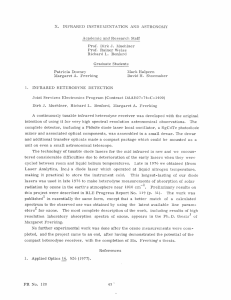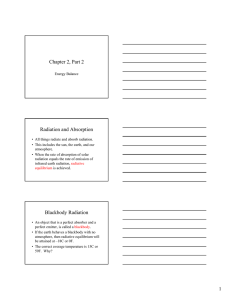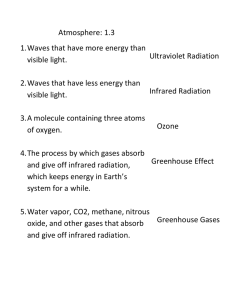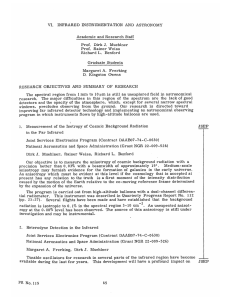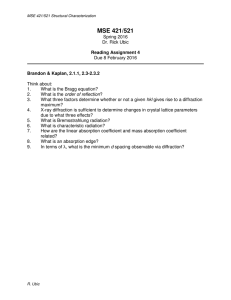Academic and Research Staff
advertisement
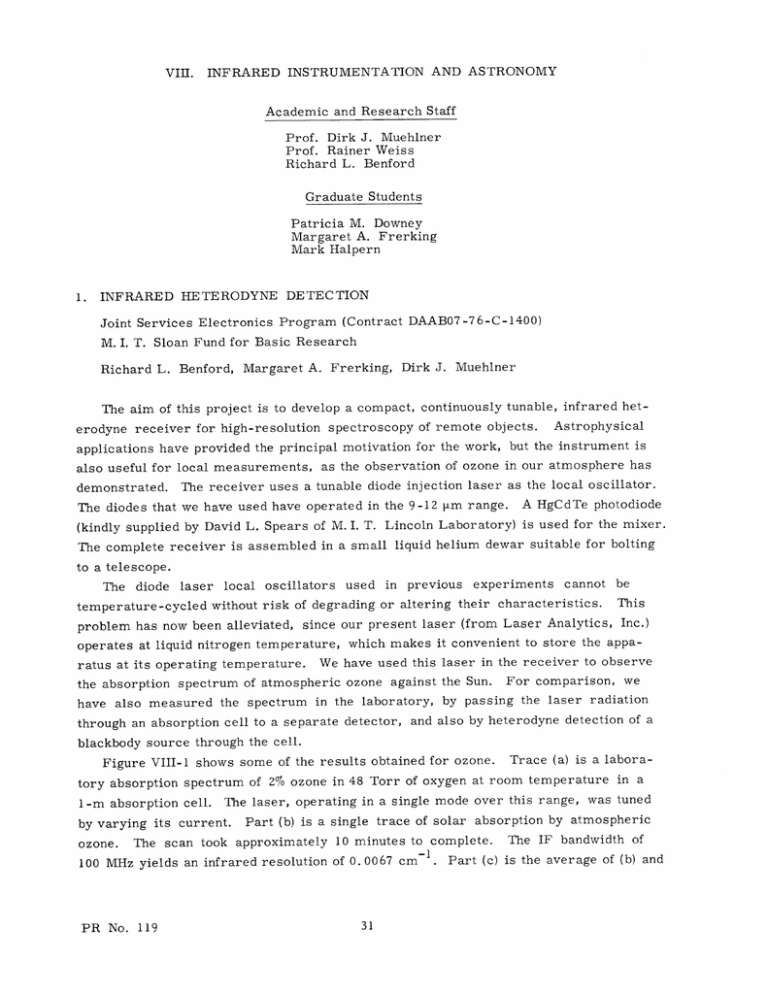
VIII. INFRARED INSTRUMENTATION AND ASTRONOMY Academic and Research Staff Prof. Dirk J. Muehlner Prof. Rainer Weiss Richard L. Benford Graduate Students Patricia M. Downey Margaret A. Frerking Mark Halpern 1. INFRARED HETERODYNE DETECTION Joint Services Electronics Program (Contract DAAB07-76-C-1400) M. I. T. Sloan Fund for Basic Research Richard L. Benford, Margaret A. Frerking, Dirk J. Muehlner The aim of this project is to develop a compact, continuously tunable, infrared heterodyne receiver for high-resolution spectroscopy of remote objects. Astrophysical applications have provided the principal motivation for the work, but the instrument is also useful for local measurements, as the observation of ozone in our atmosphere has The receiver uses a tunable diode injection laser as the local oscillator. The diodes that we have used have operated in the 9-12 [im range. A HgCdTe photodiode (kindly supplied by David L. Spears of M. I. T. Lincoln Laboratory) is used for the mixer. The complete receiver is assembled in a small liquid helium dewar suitable for bolting demonstrated. to a telescope. diode laser local oscillators used in previous experiments cannot be temperature-cycled without risk of degrading or altering their characteristics. This problem has now been alleviated, since our present laser (from Laser Analytics, Inc.) operates at liquid nitrogen temperature, which makes it convenient to store the appaThe ratus at its operating temperature. We have used this laser in the receiver to observe the absorption spectrum of atmospheric ozone against the Sun. For comparison, we have also measured the spectrum in the laboratory, by passing the laser radiation through an absorption cell to a separate detector, and also by heterodyne detection of a blackbody source through the cell. Figure VIII-1 shows some of the results obtained for ozone. Trace (a) is a laboratory absorption spectrum of 2% ozone in 48 Torr of oxygen at room temperature in a The laser, operating in a single mode over this range, was tuned by varying its current. Part (b) is a single trace of solar absorption by atmospheric ozone. The scan took approximately 10 minutes to complete. The IF bandwidth of 1-m absorption cell. 100 MHz yields an infrared resolution of 0. 0067 cm PR No. 119 - . Part (c) is the average of (b) and (VIII. INFRARED INSTRUMENTATION AND ASTRONOMY) LASER 1.31 I - f 7 i CURRENT (A) 1 I I . . 1.39 .. 1 I.0 w z0 Z Iz Ir I I I I I I I 1011.0 WAVE Fig. VIII-1. NUMBER (cm - 1) I I I011.8 Ozone absorption spectra. (a) Spectrum obtained in a absorption cell. (b) Typical atmospheric absorption obtained against the Sun by using a heterodyne receiver. age of 6 atmospheric absorption spectra. (d) Spectrum with AFCRL atmospheric absorption line parameters. laboratory spectrum (c) Avercalculated 5 similar scans. The atmospheric data were obtained on 1 December 1976, with the Sun at an elevation angle between 230 and 26'. A fit to the laboratory spectrum (a) with the use of the Air Force Cambridge Research Laboratory compilation of line parameters1 is shown in (d). spectra. There is only rough agreement between the observed and calculated According to S. A. Clough,2 of Air Force Geophysics Laboratory (formerly AFCRL), the compiled ozone parameters in this frequency region are not very accurate, and so disagreement in detail between calculated and observed spectra is not surprising. The ozone results presented here do not represent the ultimate capability of the heterodyne receiver. The local-oscillator power focused on the mixer was ~40 [W, more than five times lower than that required for shot-noise-limited detection. The output noise seen in Fig. VIII-1 was approximately 10 times larger than the amplifier noise, PR No. 119 (VIII. INFRARED INSTRUMENTATION AND ASTRONOMY) primarily because of inadequate shielding against RF interference. Also, approximately two thirds of the available solar power was lost because of inefficient transfer optics. In spite of these less than optimum conditions, we feel that the usefulness of the infrared heterodyne receiver for high spectral resolution remote sensing has been demonstrated. References 1. R. A. McClatchey et al., AFCRL-TR-73-0096, "AFCRL Atmospheric Absorption Line Parameters Compilation," Air Force Cambridge Research Laboratories, Bedford, Massachusetts, 26 January 1973. 2. S. A. Clough, Private communication, 2. DEVELOPMENT OF INTEGRATED SILICON BOLOMETERS 1976. National Aeronautics and Space Administration (Contract NAS5-23731) Patricia M. Downey, Rainer Weiss In this project we have applied the techniques of integrated circuit manufacture to the ancient art of bolometer construction. An entire bolometer assembly - mounting frame, thermal links, and low heat capacity bolometer element - has been formed out of a single piece of silicon by masking and etching. The central bolometer element incorporates an ion-implanted resistance thermometer and a thin metallic film radiation absorber. Broadband detectors with time constants of 1/10 s and radiation noise equiv- alent power (NEP) of 10-5 at 1. 5K appear to be feasible. The techniques that are employed should produce high yield rates and lead to the manufacture of detector arrays. This project is being carried out in collaboration with the Microelectronics Group at M. I. T. Lincoln Laboratory. 3. MEASUREMENT OF THE LARGE ANGULAR SCALE ANISOTROPY OF THE PRIMEVAL COSMIC BACKGROUND RADIATION National Aeronautics and Space Administration (Grant NGR 22-009-526) Dirk J. Muehlner, Rainer Weiss, Richard L. Benford The goal of this experiment is to search for intrinsic anisotropies which is adduced to be a remnant of the of the cosmic primordial cosmic backgound radiation, explosion. The high degree of isotropy of this radiation is a deep mystery and measure- ment of the angular distribution on both large and small angular scales constitutes of the fundamental problems in cosmological observation. At some one level the earliest vestige of galactic formation must have left its imprint on the primeval explosion, PR No. 119 (VIII. INFRARED INSTRUMENTATION AND ASTRONOMY) and the explosion was not necessarily spherically symmetric. ground can also be turned around: frame, Observations of the back- Under the assumption of isotropy in some reference a measure of a global anisotropy in a frame tied to the Earth will give a measure of the velocity of the Earth relative to the reference frame that was at average rest with the matter that last scattered the background radiation. The upper limits on this veloc- ity, established by isotropy experiments of the background, are in conflict with earlier systematic anisotropies measured in the distribution of galactic red shifts. In this project, which has been in progress for three years, we are conducting a balloon-borne survey of the sky, using a dual-channel differential radiometer with -l -l a 170 beamwidth. The two channels have bandwidths extending from 3 cm 1 to 10 cm-1 and from 10 cm to 25 cm. The lower frequency channel is chosen to include the bulk of the energy in the cosmic background radiation, while the higher frequency channel monitors inhomogeneities in the atmosphere and is sensitive to local astronomical such as interstellar dust clouds. approximately 0. 1°K/Hz /2 sources With existing detectors, the survey sensitivity is in the low-frequency channel. In a typical 8-hour flight it -4 is possible to set fractional temperature anisotropy limits of 3 X 10-4 on global-scale anisotropies such as those caused by the velocity of the Earth relative to the universal co-moving frame. The results of 4 balloon flights, covering approximately one third of the celestial sphere, show no anisotropies larger than 1/1000 and, with a 90% confi- dence limit, indicate that the velocity of the Earth is less than 350 km/s relative to the co-moving frame. These limits are not set by the ultimate survey sensitivity but rather by systematic correlations in the data that may well be due to galactic dust clouds or intrinsic anisotropies in the background. as greater sky coverage, 4. Improved sensitivity in the survey, as well are needed to unscramble the correlations. SKY SURVEY AT MILLIMETER AND SUBMILLIMETER WAVE LENG THS National Aeronautics and Space Administration (Grant NGR 22-009-526) Dirk J. Muehlner, Rainer Weiss, Richard L. Benford This project is closely related to the anisotropy measurements tion VIII-3. the spectral described in Sec- It is a balloon-borne survey of the sky to search for discrete sources with bands approximately 1'. used in the anisotropy experiment but with a smaller beamwidth, A spin-scanned telescope that has a sensitivity of ~104 flux units per angular resolution element is used in the experiment. With improved detectors such as those described in Section VIII-2, we hope to increase the sensitivity to 100 flux units. Aside from mapping the sky in this unknown spectral region, our goal is to measure the frequency dependence of the emissivity of typical dust clouds in our Galaxy. surveyed the galactic plane from longitude -50 to +500. PR No. 119 We have The emissivity of the dust in the (VIII. INFRARED INSTRUMENTATION AND ASTRONOMY) galactic center has been found to vary faster than linearly with frequency. Limits on the millimeter and submillimeter brightnesses of several sources observed at 100 Im have also been set. 5. COSMIC BACKGROUND EXPLORER SATELLITE (COBE) National Aeronautics and Space Administration (Contract NAS5-23731) Mark Halpern, Rainer Weiss We are engaged in a one-year study with scientists from several other laboratories to investigate the feasibility of using a single integrated satellite to carry out the following measurements of the cosmic background radiation: A precision measurement of the spectrum of the background radiation between 3 cm-1 and 20 cm-1 by using a cryogenic Fourier transform spectrometer. The design goal is to make an absolute determination of the spectrum with a signal-to-noise ratio of 1000/1 at the blackbody peak. The instrument is designed to measure the deviations a. from a Planckian spectrum. An absolute measurement of the diffuse background in 6 broadband channels between 300 pm and 10 im. The background radiation in this spectral region is virtually b. unknown, particularly in the 100 - 300 ym band. A multiband measurement of the anisotropy of the cosmic backgound radiation, The with the use of microwave differential radiometers at 20, 30, 55, and 90 GHz. angular scale will be of the order of 70 with a fractional temperature sensitivity of c. 0. 2 millidegrees per resolution element extending over the entire sky in a one-year flight. This project, if approved by NASA for continued support, should lead to the most authoritative measurement of the background radiation. Collaborating with us are John Mather and Michael G. Hauser, of Goddard Space Flight Center, David T. Wilkinson, of Princeton University, Samuel Gulkis, of the Jet Propulsion Laboratory, California Institute of Technology, and George F. Smoot III, of the University of California at Berkeley. PR No. 119
